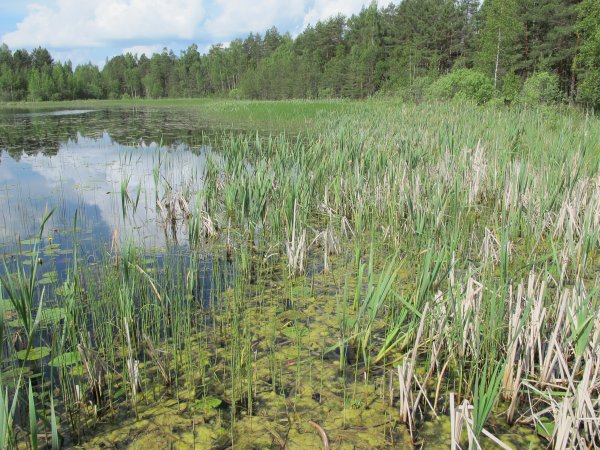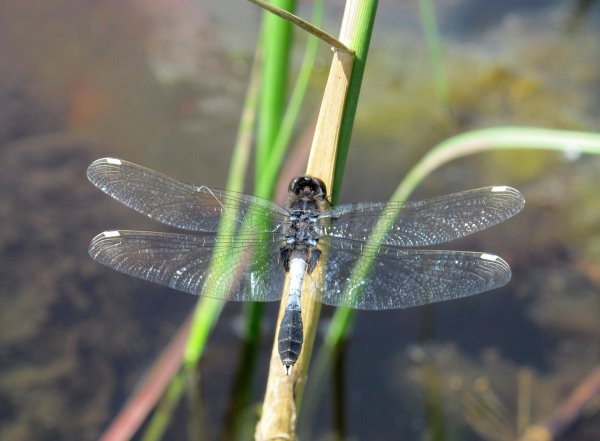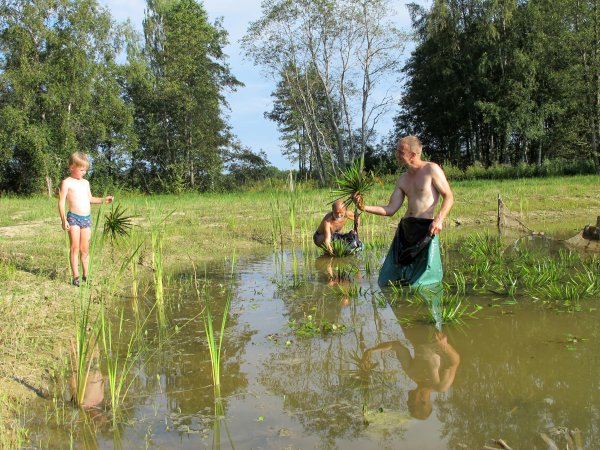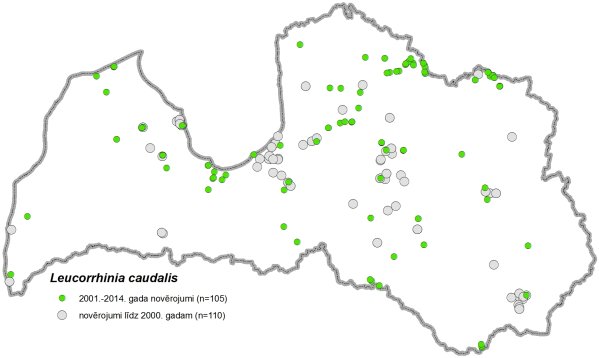PROTECTION PLAN FOR LILYPAD WHITEFACE DEVISED
Picture: lilypad whiteface.
Lilypad whiteface (Leucorrhinia caudalis) - a species found in Latvia, believed to be endangered, is protected by various endangered species laws and regulations in all of Europe. A protection plan for lilypad whiteface was devised and initiated last year, as part of the project "Development and implementation of a species protection plan for lilypad whiteface (Leucorrhinia caudalis)", funded by the Latvian Environmental Protection Fund.
What is a species protection plan?
In order to protect an animal or plant species, it is not enough to merely recognize it as endangered and include them on some list. In order to protect a species, its habitat and lifestyle has to be explored first. It is important to understand by whom and where this species is threatened. When these aspects are clear, specific measures need to be drawn up in order to eliminate the threat. A species protection plan is like a manual, containing brief and precise explanations on how and where specific measures need to be taken.
Lifestyle of lilypad whiteface
Lilypad whiteface can be encountered in Latvia most often near lakes that are rich in plants (eutrophic lakes), as well as swampy (oligotrophic) lakes and “old man” rivers. Locations, where the lilypad whiteface species live, usually exhibit all three aquatic plant subgroups – submersed, floating leaf, and emergent. Lilypad whiteface is a predator – its larvae live in water, while adult insects live above the water level and mainly feed off other invertebrates. Today, lilypad whiteface inhabits the entire territory of Latvia. However, when comparing data between the historical and contemporary spread of the species, one can conclude that the species is now encountered less, which indicates that its population could be decreasing in Latvia.

Picture: habitat of lilypad whiteface – a swampy (oligotrophic) lake, rich in plants..
What threatens lilypad whiteface?
Natural enemies, foreign species (for example, fish, such as the Chinese sleeper), insect collectors, extreme weather conditions, poisonous substances in the habitat, and the small population are the main factors that affect lilypad whiteface. However, almost all of these factors leave a small or medium effect on lilypad whiteface. Foreign species and the small population could also possibly have a larger impact. The disappearance of the species' biotype has a small impact, as it has happened only in specific places so far. Fragmentation of biotypes (isolation of deposits), habitat management (cleaning of water bodies), and non-management of foreshores (overgrowing) can be assessed similarly. As is the case with many species, there is no single factor that would have a major impact; however, with several negative aspects adding up, a much larger impact might be left on the population of the species in Latvia (nevertheless, there still are more questions than answers to many cases due to lack of information).
How to eliminate the threat?
The species protection plan includes protective measures of lilypad whiteface in various sectors, such as legislation, nature protection planning, protection of species and its habitat, research and monitoring, information and education. Some of the said measures apply entirely on the protection of invertebrates or even species and biotypes. Here are examples of some of the applicable measures:
- Preparation of data on lilypad whiteface deposits, and handing the data over to the nature management system "OZOLS" and JSC "Latvian State Forests" data base – nature protection specialists, territorial planners, permission issuers, managers, and the responsible institutions have no access to qualitative and complete information on lilypad whiteface deposits. Only by knowing precise locations of this species' deposits, it will be possible to plan and introduce their proper protection.
- Experimental creation of new habitats – at the moment there is no known experience in creating them; furthermore, places, where small populations are mutually separated, pose greater risks for these populations to disappear. By creating new habitats in between populations, they can be merged and thus become more resistant against the negative factors.
Picture: creation of a new habitat – of water soldiers' habitat.
- Control of monodominant (homogeneous) common reed population in lilypad whiteface deposits – because of the formation of homogeneous common reed, a number of lilypad whiteface deposits have a limited number or no floating leaf aquatic plants at all, including the floating leaf zones which limit the population of dragonflies in the deposit.
- Inspection of historically-known deposits of lilypad whiteface and search for new deposits – only a part of the potential number of lilypad whiteface deposits have been discovered in Latvia so far, while the undiscovered deposits are under a threat of loss. There is no current data on the species occurrence in many historical deposits, which limits opportunities for assessing the population condition for a longer period of time.
- Training in the protection of dragonfly species for individuals and institutions – knowledge about the aspects of the protection of dragonfly species is at a low level at the moment, which further causes risks in the protection of lilypad whiteface and other dragonfly species, as well as hinders news specialists and enthusiasts from taking interest in the issue.
How is lilypad whiteface linked to forests and JSC "Latvian State Forests"?
Lilypad whiteface is not a typical forest species, yet it often lives near water bodies that are part of a forest. Forest management affects the quality of water and coastal zones. Young forest plantations, firebreaks, and roads serve as feeding or migration places for dragonflies. The majority of dragonflies, especially species of smaller population, do not cross forests (forest areas are a natural barrier). JSC "Latvian State Forests" manages not only forests, but also meadows, bogs, and water bodies. More than 30 deposits (out of ~115) were detected directly within territories managed by JSC "Latvian State Forests".
Picture: the spread of lilypad whiteface in Latvia..
Current species protection plans can be found on the Nature Conservation Agency's website, section Conservation plans (the protection plan for lilypad whiteface will be published after the environmental protection and regional development minister's approval).





